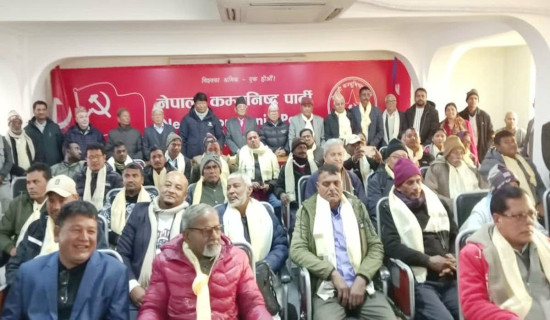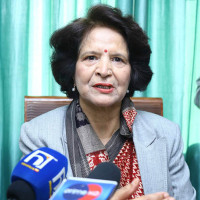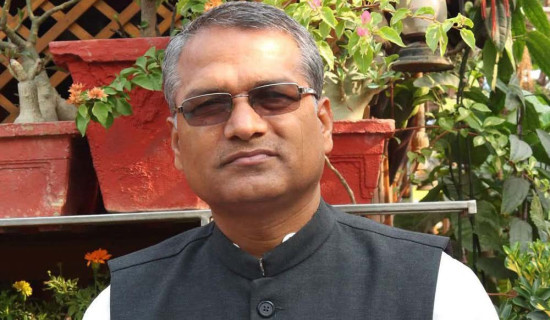- Saturday, 27 December 2025
One Year of Government Special Supplement
Appreciable Achievements In ICT
Nepal is experiencing major changes brought about by the widespread adoption of digital technologies. As the digitalisation of public services takes hold in local, provincial, and federal levels, all Nepali people - regardless of their location, identity or social status - are getting faster, more economical and effective services with every passing day. And underpinning this revolution is information communication technology (ICT). Today, a vast majority of services, from applying for driving license to making property-related transactions, have moved online. Several hospitals, including Karnali Provincial Hospital in Surkhet, have launched online booking system for patients to register, make appointments to see doctor of their choice on their preferred date, among other services. As the government doubles down on its effort to make these crucial technologies even more accessible in remote corners of the country and integrate them into e-governance, public services are expected to get even better. During the past year, there have been notable works in this sector, accelerating the pace of digitisation.
Achievements
ICT has played a crucial role in enhancing e-governance, facilitating easy access to government services and information for citizens. Through online portals, they can access various government services anywhere and anytime and without requiring them to be physically present. ICT tools, like Nagarik App and other social media platforms and online forums, have enabled the three-tier governments to engage with citizens, collect feedback and incorporate them in decision making processes, increasing people’s participation in governance. Not only has this given voice to the voiceless but has also empowered them to have their say in the decisions that affect them.
Five new public services have been added to Nagarik App, including the driving license, taking the total to 62. IT has also aided in the collection, storage, and analysis of vast amounts of data, which in turn has helped government agencies make informed policy decisions and optimise resource allocation. This has also reduced paperwork, administrative costs, and processing time, leading to cost savings for both governments and service-seekers, and enabling the former to be more responsive to the needs, concerns and demands of the latter.
Adoption of cloud computing has made matters even sweeter. When government agencies operate their systems through their own infrastructures, the cost of human resource management and infrastructure will increase, so the concept of creating a shared infrastructure of the Government Cloud has been introduced for maximum use at the minimum cost.
The necessary resources (CPU, RAM, Storage, Public IP, among others) are provided to Nepal government agencies to host and operate websites and web applications, backup important data, and operate information technology related systems. Through this technology, resources are provided as free virtual computer equipment from a common platform prepared by connecting server, storage, network device, security device and other computer equipment.
Today the Government Cloud hosts 337 government agencies and operate 807 virtual machines. In essence, cloud computing empowers governments to operate more efficiently, securely manage data, enhance service delivery, and adapt quickly to changing needs, ultimately contributing to better governance. The result is clear for all to see government machineries have become more transparent, leaving little or no space for corruption to rear its ugly head.
ICT when coupled with internet empowers the former to a whole new level. It is via the internet these tools deliver their services. The internet’s global nature ensures that ICT solutions, services, and information are accessible globally, providing the infrastructure and connectivity needed for these tools to function.
And optical fibre has so far been the most important medium for the internet to transmit high-bandwidth data at lightning speed over a long distance in the most reliable way. It forms the backbone of internet infrastructure, connecting internet service providers (ISPs) to the users and all other computer networks. This past year, the government has been able to expand the optical fibre based FTTH (Fibre to the Home) to the remote districts of Taplegunj, Bajhang, Bajura, West Rukum, Jumla, and Kaliot, bringing the total number of districts with such facility from 67 to 73 and its length from 12230 to 15000 kms. This has laid the groundwork for the density of internet users to reach 134.76 per cent from 131.5 per cent over the period.
In the same vein, the expansion of 4G/LTE has grown from 63.81 per cent to 67 per cent. Trial works to launch 5G has also been initiated. To track the lost cell phone, the Online Tracking System (MDMS) has been brought into operation. Broadband internet has been installed in all local level offices, 10,146 community schools, and 4,390 health centres. Distribution of very high-speed internet (1 Gbps) based on XGPON technology has been started. In an effort to preserve Gorkhapatra Corporation as the national heritage, digital archiving of its publications right from its founding year 1958 is in the works, with 1655 audio contents of Radio Nepal already being digitised and archived.
Future course
The nature of technology is such that it upgrades rapidly, meaning that newer updated version of the technology currently in use has already been rolled out. So, staying complacent can never be an option. Artificial Intelligence (AI) has taken the world by storm, bringing and promising revolutionary changes.
To stay relevant and avoid the risk of falling behind, adoption of AI-powered tools in critical sectors is imperative. One such sector is weather forecasting. Nepal is a country highly prone to natural hazards, with floods, landslides, wildfires and other natural disasters claiming hundreds of lives and destroying or damaging properties worth billions every year.
Many countries, including India, are making use of AI to build climate models to improve weather forecasting as extreme weather events get increasingly devastating.
AI is so appealing because it has already outperformed conventional forecasting models in precision and cost. That means it can generate higher quality data at lower cost, obviating the need for costly super computers presently in use. Accurately forecasting devastating natural hazards like drought, floods, and heat waves means saving lives and properties in the event of their arrival. So, the country cannot afford to remain a laggard in developing and harnessing the power of AI. Steps must be taken towards this direction.
(Basyal is a journalist at The Rising Nepal.)






-original-thumb.jpg)










